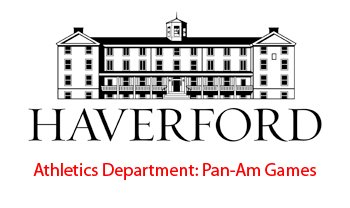As we prepare to welcome the largest influx of hoops talent ever to set foot on Haverford’s campus for July's Pan-American Games Trials, (apologies to
Dick Voith ’77) it’s important to get a sense of what these hoopsters are aiming to accomplish within the walls of the Gooding Arena.
Aside from testing the strength of the rims and backboards, thirty top Division-I all-stars will play for twelve spots on the roster, and twelve seats on a plane headed for Rio de Janeiro, Brazil and Pan-American Games XV.
Since the advent of this intra-America's competition in 1951, the
U.S. men have captured eight gold medals, three silvers and one bronze over the course of fourteen Games.
As impressive as these numbers are, the
U.S. has not demonstrated their expected dominance in recent years.
The last time they stood atop the victors’ podium was in 1983, when a twenty-year old guard from UNC, by the name of
Michael Jordan pumped in an impressive 17.3 points per game alongside his Tar Heel teammate
Sam Perkins’ 13.1 ppg.

(
Jordan’s holding the ball in the center of the picture.
I can’t make out who’s who, but somewhere in this shot of the entire 1983 gold-medal winning USA squad, you can find St. John’s shooter
Chris Mullin, Georgia Tech guard
Mark Price, ’Nova forward
Ed Pinckney, UNC's Sam Perkins and OU Sooner
Wayman Tisdale.)
The Haverford-hosted Trials are central to reversing the twenty-four year gold medal drought and the embarrassing fourth place finish in 2003.
Making the trek all the way from
Lancaster Ave. to call the shots is Villanova head coach
Jay Wright.
He has the responsibility of taking full advantage of Big East rival C
Roy Hibbert, (
Georgetown) possibly the
U.S.’s most potent weapon.
It was Hibbert who led the Hoyas to the Final Four before falling to C
Greg Oden, PG
Mike Conley, Jr. and
Ohio State.
Oden and Conley, both freshman during their run through March Madness, would be eligible to play in
Brazil if they weren’t headed off to be lottery picks in this month’s NBA draft.
These ten days of basketball, which include a three-day tryout from July 12-14, to be followed by five days of practice, are central to bringing USA Basketball back to its spot atop the field.
The drills, scrimmages and strategy for which the Gooding Arena will bear witness will likely determine the fate of winning that elusive ninth gold medal.
Before leaving for the 1979 Pan-Am games, in which the U.S. pounded the competition with a 9-0 record and an average margin of victory of more than 21 points per game, future three-time NBA Champion
Kevin McHale called the Trials, not the Games, “my awakening as a basketball player.”
His epiphany is not meant to be a prophetic prediction that some other lanky middle-American forward will blossom into an elite low-post presence – well…maybe if someone taught
Brian Butch (6’11’’ 245 lbs.,
Wisconsin) McHale’s signature “up-and-over” we might have something here.
Instead, McHale’s admission highlights the life-altering nature of this event.
These college-aged kids must elevate their level of play for something greater than a national audience.
This time around, it’s for national pride and maybe even international glory.


(Kevin McHale, a legend of the low-post, above)
(Brian Butch, Wisconsin, below)
Nine of the NBA’s 50 Greatest Players have competed at this event, only one of whom (David Robinson - 1987) fell short of coming home with gold. One month from today we will know whose flight is booked for Brazil and who is headed home.




No comments:
Post a Comment